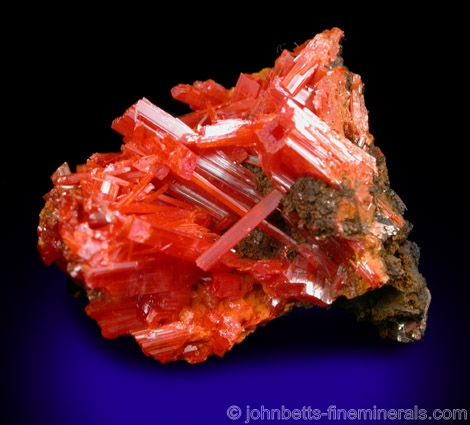The Mineral crocoite

With its beautiful deep orange-red color, Crocoite is a mineral that intrigues collectors. It was first found in Russia and later in other European localities, but only sparingly and in typically small crystals. The Australian discovery on the island of Tasmania took this mineral to a whole new level when large, brilliant, well-formed crystals larger and more abundant than any other localities were found. The original crystals from this discovery yielded phenomenal crystals and aggregates, although excellent material is still coming out of these mines as they are now being mined for specimen production.
Crocoite, originally called "Red Lead Ore," has several other historical names. Its current recognized name was established by German
mineralogist August Breithaupt as "Krokoit", which has been anglicized to its present name of Crocoite. Its name is derived from the Greek word for saffron, alluding to the color and habit of saffron threads which very much resemble this mineral. Crocoite specimens are generally fragile, and care should be taken when handling.
Crystal System
Monoclinic
Properties
Streak
Orange-red with a yellow tint |
Hardness
2.5 - 3 |
Transparency
Translucent |
Specific Gravity
5.9 - 6.1 |
Luster
Adamantine |
Cleavage
3,1 - prismatic |
Fracture
Uneven |
Tenacity
Brittle, but very slightly sectile |
Uses
Crocoite was at one time a main ore of chromium, but it is now too rare to be used. Crystals are highly sought after by mineral collectors because of their attractive color.
Noteworthy Localities
The Adelaide Mine and the Red Lead Mine in Dundas, on the island of Tasmania, Australia, is where Crocoite is most abundant, and where the most magnificent crystals come from. Finds in both the 2010 Pocket and the 2012 Red River Find in the Adelaide Mine are especially noteworthy. New specimen production has also been conducted in the Red Lead Mine.
Crocoite was found in Berezovsk, Sverdlovsk (Yekaterinburg), in the Ural Mountains of Russia; Callenberg, Saxony, Germany; Nontron, France; and Congonhas de Campo, Brazil. It also comes from the Australian mainland in the Happy Jack Mine, Menzies, Western Australia.
In the U.S., only small amounts were found, only capable of being micromounts. Occurrences include the Mammoth Mine, Tiger, Pinal Co., Arizona; the El Dorado Mine, Indio, Riverside Co., California; and Darwin, Inyo Co., California.
Distingushing Similar Minerals
Wulfenite, Cinnabar, and Vanadinite - Form in different crystals.
Realgar - Softer, lighter in weight.
Cuprite var. Chalcotrichite - Harder, occurs in different localities.